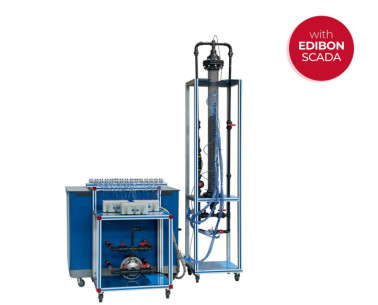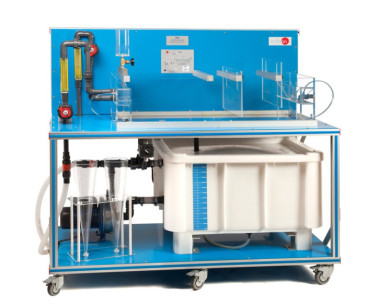EMLS Liquid/Solid Mixing Unit
INNOVATIVE SYSTEMS
The Liquid/Solid Mixing Unit, "EMLS," designed by EDIBON, facilitates the study and optimization of mixing liquids and solids. It includes a robust support with a variable speed motor and mechanical connections for installing various agitators.
Laboratories
RELATED NEWS
General Description
The Liquid/Solid Mixing Unit, "EMLS," designed by EDIBON, facilitates the study and optimization of mixing liquids and solids. It includes a robust support with a variable speed motor and mechanical connections for installing various agitators. These adjustable components adapt to different mixtures and industrial applications.
The "EMLS" allows controlling the intensity of agitation and using agitators of different sizes to achieve homogeneous dispersion. The height-adjustable mobile platform enables positioning the agitator according to the volume and type of material in the tank. Transparent tanks facilitate real-time observation, and lids prevent splashing.
This unit enhances the knowledge of students and professors in chemical engineering. Students gain practical experience complementing theoretical learning, while professors can demonstrate complex principles clearly and tangibly. Safety features automatically disconnect the system when the door is open or the agitator is in the highest position.
The "EMLS" is designed for optimal functionality and safety, featuring an adjustable motor, vertical adjustment system, interchangeable agitators, and transparent tanks. These characteristics ensure a safe and efficient working environment.
The "EMLS" is an advanced solution for education and research, providing a deep understanding of liquid/solid mixing. Its versatile and secure design makes it ideal for students, professors, and researchers, enriching knowledge and preparing future professionals for challenges in chemical engineering and other industries.
Exercises and guided practices
GUIDED PRACTICAL EXERCISES INCLUDED IN THE MANUAL
- Visualization of fluid fields.
- Power required in the agitation process.
- Suspensions of solids in liquids.
- Formation of solid-liquid solutions.
- Emulsion of immiscible liquids.
- Mixing of miscible liquids.
- Heating process of liquid mass.
- Test with models at scale.
- Quality of mixing / mixing time.
- Power speed of the different agitators.
- Demonstration of the different factors (tanks, deflectors, agitators...), that affect the mixing, using visualization techniques and appropriate measurement.
SUPPLEMENTARY EQUIPMENT
Computer Controlled and Touch Screen 1000 l Semicontinuous Centrifugal Separator
Computer Controlled Continuous and Batch Filtration Unit
Continuous and Batch Filtration Unit
Computer Controlled Plate and Frame Filter Press
Computer Controlled Deep Bed Filter Unit
Deep Bed Filter Unit
Sedimentation Study Unit
Computer Controlled Sedimentation Tank
Sedimentation Tank
Computer Controlled Drainage and Seepage Tank
Drainage and Seepage Tank
Quality

AFTER-SALES SERVICE

 Cookie preferences
Cookie preferences


















